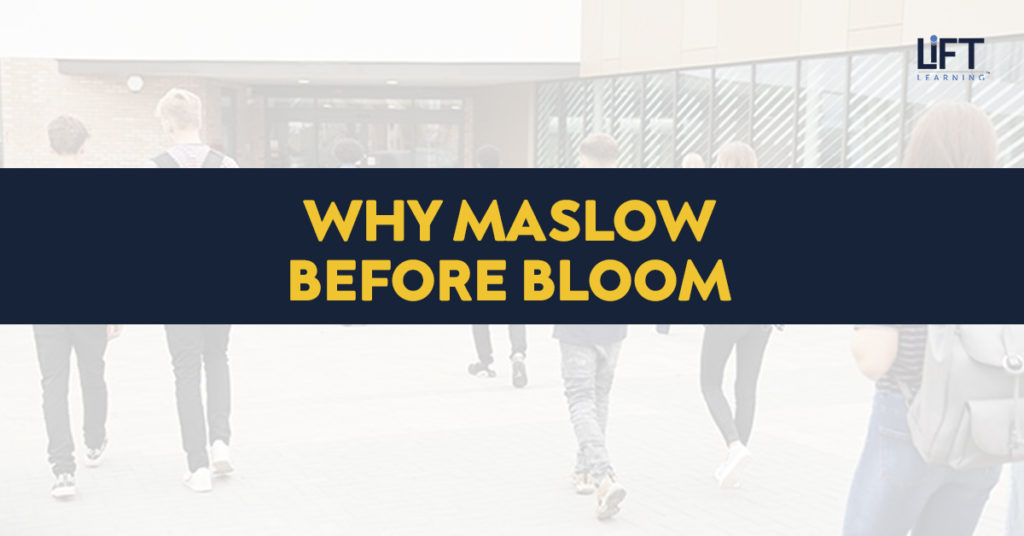Maslow Before Bloom

What is Maslow Before Bloom?
“Maslow Before Bloom” is a phrase educators use to remember that a hierarchy of human needs must be satisfied before the full potential of students’ ability to create and think critically can occur. In other words, human needs like health, safety, love, and belongingness (Maslow’s Hierarchy of Needs) must come prior to students applying memorized concepts to produce original, complex, and thoughtful work, as understood by Bloom’s Taxonomy.
Maslow and Bloom refer to two American psychologists, Abraham Maslow and Benjamin Bloom. A basic familiarity with their thinking is essential to understand the psychology behind the term Maslow before Bloom.

Maslow’s Hierarchy of Needs
Abraham Maslow created a hierarchy of needs that includes five tiers: physiological, safety, belonging, esteem, and self-actualization. The two lowest tiers address basic needs such as food, water, shelter, safety, sleep, clean air, clothing, and warmth. When students’ basic needs are not being met, it is going to be a challenge for them to succeed in school. The next two tiers, belonging and esteem, are also important needs for students’ well-being.
The last tier, self-actualization, refers to the search for personal growth that happens when the other tiers are being met. Project-based learning supports Maslow’s hierarchy of needs by allowing for greater connections to be formed in the classroom.
A greater sense of belonging and self-esteem results from giving students choices in what and how they learn and by incorporating collaboration and teamwork. These components, choice and voice, problem-solving, and collaboration, are a few of the many desirable attributes of PBL.
Bloom’s Taxonomy of Educational Objectives
Bloom created a taxonomy of educational objectives or cognitive tiers for learning. They are knowledge, comprehension, application, analysis, synthesis, and evaluation.
According to Bloom’s taxonomy, there are three categories of learning: knowledge, attitude, and skills. Each level of learning becomes more complex, but individuals must move through the stages to reach the higher levels.
A project-based learning approach provides learners with opportunities to move through each of the levels of learning in Bloom’s taxonomy. Rather than focusing primarily on knowledge and comprehension, students in a PBL classroom are given opportunities to apply what they learn to the real world, comprehend the content on a deeper level, and reflect on the learning process.
How do we “Maslow Before Bloom?”
There are several ways to facilitate “Maslow before Bloom” in the classroom. When basic needs are not being met, helping students develop coping strategies for their emotions, supporting them, and modeling these strategies can be helpful. Working with and supporting families during stressful times in order to create a strong foundation can help put the focus on Maslow in order to set the stage for Bloom. The daily interactions that occur in a PBL environment provide more opportunities for teachers to identify and address students’ needs.
Welcoming students
Personally greeting each and every student at the beginning of the day is an important strategy for checking in on his or her physical, social, and emotional well-being. For middle and high school, this can be repeated at the beginning of each individual class meeting. Welcoming students enhance their sense of belonging to a community. A study done in 2018 showed that positive greetings at the start of the day increased academic engagement and decreased disruptive behavior.
Greeting young students at eye level and making eye contact with them helps them to feel connected, secure, and safe. Giving them choices about how they want to be greeted helps them feel comfortable, empowered, and respected. Starting the day with personal greetings aids children in making the transition from home to school. It shows them that their presence and participation are valued and sets the stage for their successful engagement during the school day.
Use it all day long
Once the initial greetings have occurred, the stage is set for the rest of the day. However, a connection formed should not end there. Teachers should continue to provide opportunities for interacting with their students and checking in throughout the day. This can be done by taking short breaks, letting them get out of their seats and move around, or giving them time to relax and socialize with their friends.
Building trust
Providing opportunities and safe spaces for students to share their feelings and experiences is important for building trust. Teachers can share their own experiences with students to set a positive example and to make them more accessible and relatable. By creating relationships and bonds, PBL contributes to the building of trust that is so essential for students’ success in school and in life.

References
Berger, Tom. “How to Maslow Before Bloom, All Day Long.” Edutopia, September 2, 2020.
Mullen, Greg. “Maslow Before Bloom.” Exploring The Core. November 17, 2020. https://www.exploringthecore.com/post/maslow-before-bloom
Scoggins, Isaac. “We Have to Maslow Before We Can Bloom.” McGraw Hill. https://medium.com/inspired-ideas-prek-12/we-have-to-maslow-before-we-can-bloom-36cd78dc22a0
Seton, Henry. “A Daily Ritual That Builds Trust and Community Among Students.” Edutopia. January 8, 2021.
As a New Hampshire educator at the forefront of the competency-based movement, Joey taught Cultural Geography in grades 9-12 at Pinkerton Academy. He was awarded New Hampshire’s Teacher of the Year in 2014 before taking a leadership role as Director of Education at Education First. At EF, he was responsible for improving the learning experience of participants in travel programs through accreditation, strategic partnerships, and product development.

